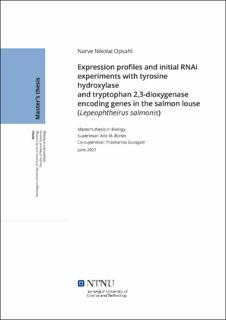| dc.contributor.advisor | Bones, Atle M. | |
| dc.contributor.advisor | Guragain, Prashanna | |
| dc.contributor.author | Opsahl, Narve Nikolai | |
| dc.date.accessioned | 2021-09-25T16:04:12Z | |
| dc.date.available | 2021-09-25T16:04:12Z | |
| dc.date.issued | 2021 | |
| dc.identifier | no.ntnu:inspera:79416900:46980420 | |
| dc.identifier.uri | https://hdl.handle.net/11250/2782507 | |
| dc.description.abstract | Lakselus er en ektoparasittisk copepode på laksefisk. Den fører til betydelige økonomiske tap i oppdrettsindustrien, samtidig som den representerer en velferdstrussel for oppdrettslaksefisker og en mulig trussel mot ville anadrome laksefiskpopulasjoner. Eksperimentell posttranskripsjonell nedregulering av spesifikke gener ved RNA interferens (RNAi) er en metode for å karakterisere funksjonen til gener i mange organismer, inkludert lakselus, og eksperimentell RNAi har blitt oppnådd i flere av lakselusas utviklingsstadier. RNAi kan, sammen med andre teknikker, øke kunnskapen om interaksjoner mellom parasitt og vert, samt bidra til å identifisere molekylære mål for kjemisk behandling og mulige vaksineantigen.
I dette prosjektet ble de to genene LsPale og LsTDO, som koder for henholdsvis tyrosin hydroksylase (TH) og tryptofan 2,3-dioksygenase (TDO) hos lakselus, studert. De to enzymene er viktige i metabolismen av flere nevrotransmittere, pigmenter og andre metabolitter av tyrosin og tryptofan. Fylogenetiske analyser viste at begge genene hører til sine artropode genfamilier, og at de er nært beslektet med tilsvarende gener i andre hoppekreps. En nedregulering av de to genene ved RNAi ble også forsøkt i lakselusas nauplii-larver. LsPale ble nedregulert suksessfullt, og nedreguleringen var detekterbart i mindre enn syv dager. Ingen morfologiske eller adferdsmessige endringer ble observer tre og syv dager etter behandling, men larvene var inaktive rett etter at dobbeltrådet RNA (dsRNA) ble introdusert. Genutrykksprofiler av de to genene viste at LsPale er sterkt oppregulert før og gjennom den metamorfologiske forvandlingen til copepoditt og at LsTDO er utrykt i både i lakselusas planktoniske og parasittiske utviklingsstadier, med en topp i preadult og adult.
Siden resultatene indikerer at genene er involvert i flere av lakselusas utviklingsstadier, burde det gjøres mer arbeid for å karakterisere de to genene. Videre medvirker sannsynligvis LsTDO i øyepigmentering, og kan potensielt fungere som en seleksjonsmarkør om CRISPR/Cas9-basert genredigering skal utvikles for lakselus. Dette prosjektet illustrerer også at RNAi i lakselus er utfordrende, til tross for flere publikasjoner der lignende RNAi-basert metodikk er benyttet. | |
| dc.description.abstract | The salmon louse is an ectoparasite copepod on salmonids. It causes substantial economic loss in the salmon industry and represents a welfare threat to farmed salmonids and a potential threat to the sustainability of several wild salmonid populations. Experimental post-transcriptional knockdown of specific genes by RNA interference (RNAi) is a method used to characterize the function of genes in many organisms, including the salmon louse, and experimental RNAi have been achieved in several of the salmon louse’s developmental stages. RNAi, in combination with other techniques and methods, might expand the understanding of parasite-host interactions, as well as help identify molecular targets for novel chemical treatments and vaccine antigens.
In this project, the two genes LsPale and LsTDO in the salmon louse, encoding tyrosine hydroxylase (TH) and tryptophan 2,3-dioxyganease (TDO), respectively, were studied. The two enzymes represent key steps in the metabolism of several neurotransmitters, pigments, and other metabolites of tyrosine and tryptophan. Phylogenetic analysis revealed that both genes belong to their arthropod gene families and are closely related to corresponding copepode genes. Further, the two genes were knocked down by RNAi in the salmon louse nauplii stages. A successful knockdown was only obtained for LsPale, and the knockdown was detectable for less than seven days. No morphological or behavioral changes were observed at three or seven days after treatment, but larvae were inactive immediately after double-stranded RNA (dsRNA) delivery. Expression profiling of the two genes revealed that the expression of LsPale is strongly increased before and through the metamorphotic molt to copepodite and that LsTDO is expressed in both the planktonic and the parasitic stages of the salmon louse, with a peak in preadult and adults.
As the results presented here indicate that the genes are involved in important developmental phases in the life cycle of the salmon louse, more work should be conducted to characterize the function of the two genes. It is also suggested that LsTDO might play a role in eye pigmentation, and therefore could serve as a suitable selection marker when developing CRISPR/Cas9 based genome editing method for salmon louse. Further, the project illustrates that, despite several publications where similar RNAi-based methods are used in salmon louse, RNAi studies in salmon louse are challenging. | |
| dc.language | eng | |
| dc.publisher | NTNU | |
| dc.title | Expression profiles and initial RNAi experiments with tyrosine hydroxylase and tryptophan 2,3-dioxygenase encoding genes in the salmon louse (Lepeophtheirus salmonis) | |
| dc.type | Master thesis | |
